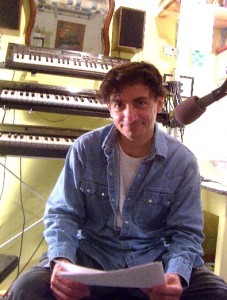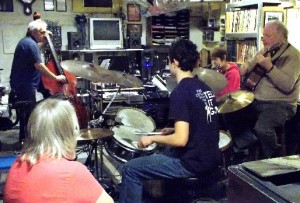“If I had a room like this I’d never leave it.” Stan Smith, head of the jazz/contemporary guitar curriculum at Capital University referring to my basement recording studio.
I made my first multi-instrument recording when I was 12. I had been teaching myself to play guitar from a book, and at the end of the book there was a duet for guitar and bass. Since my father had already gotten me started playing bass guiter, I recorded that part on a cassette recorder, then played the guitar part along with it. It wasn’t a very good song, but it did open up a new world to me, and I soon was using two cassette recorders to record songs with 4 or 5 parts.
In high school I converted my walk-in closet to a recording studio, using an old reel-to-reel machine and an inexpensive cassette deck. Since my finances were as tight as my workspace, I began trying to build electronic equipment from plans I found in magazines. It was years before any of them worked, but after that my ability to build (and sometimes even design) what I couldn’t buy kept me going.
In the 80s the personal computer revolutionized the recording business by making both recording and editing easier and more affordable. In 1986, just a year after we were married, Lori and I opened the Bats’ Nest Studio in the upstairs of our rented home (it took its name from the bats residing in the adjacent attics). We had to really fight city hall for a zoning variance in order to operate a business from our home, but for the next five years we recorded everything from singer/songwriters to rock and roll bands and even a church choir.
In the early 90s we started our family and moved into my grandparents’ home. The recording equipment was stored in a spare bedroom for about 5 years until we fixed up a room in the basement for it. As technology improved (and dropped in price), we moved from recording on tape to using just computers.
Here’s a photo of the old Bats’ Nest, taken in 1987 when the St. Anthony’s choir was recording a Christmas cassette:
Here’s a photo of my cousin Irene with me in my basement studio in the early 2000s:
When this photo was taken, I recorded with a Roland VS-880 and did my editing with a computer. It was a very long process, but much easier than trying to edit reel-to-reel tape.
Here are some photos of how my studio looked in 2011:
I use an old set of Kent drums that I believe date to the 1940s. The snare drum is newer.
Though I seldom record with them, I love hand percussion instruments.
I’ve had the Casio CZ-101 in the top tier since 1985. It still comes in handy now and then…
I wanted to learn to play the string bass when I was in fifth grade, but was too short, so each year the band director would check my height. Finally, by the time I started eighth grade I had grown enough to play it. I was already playing bass guitar, so the transition wasn’t too difficult. Though harder to transport and amplify, I soon came to prefer string bass to bass guitar.
Having to record myself has made it necessary to cluster everything together so I can reach things easily. That, in turn, has forced me to build my own studio furniture.
Behind the guitar are many of my father Frank’s collection of 78 rpm records from the 30s and 40s.
I share my studio space with the furnace and water heater, and have to turn the furnace off when recording in the winter. The room behind my studio was originally used to store coal for the furnace; now I store things there and also have my electronics workbench in that small room.
The Silvertone bass guitar on the rear wall is what really got me into music. When I was 12, I heard a jazz combo playing on TV. I was so taken with Arvell Shaw‘s bass guitar solo on Indiana that I badgered my father into buying this bass used for $50. It originally had the label from a beer bottle taped to it, but my mother made me take it off.
This is where my son William and I design the graphics for the CDs I produce.
These are the recordings I’ve been involved in making, dating back to an LP of the high school choir made when I was a freshman.
Over the years some famous friends have visited The Lizard’s Lair, including humanitarian and Emmy-nominated composer Joseph Curiale (left) as well as jazz flutist Ali Ryerson (who’s CD, Game Changer, spent six straight weeks in the jazz Top 10 in 2013) and guitarist/educator Stan Smith. I’d arranged for Ali and Stan to do a two-day educational residency at the local school, and my son Thomas and I (Thomas plays drums as well as vibraphone) provided their rhythm section. In this photo we’re rehearsing while my wife Lori listens.












